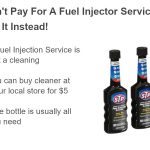You’re probably always pretty good at keeping an eye on your gas level. In fact, watching gas prices, gauging how far you can get on a small amount of gas, and leaving room in your budget for transportation costs is something that we’ve all gotten used to doing over the past few years.
There’s also the fact that, if you run out of gas, you know your car isn’t going very far. That’s why we pay so much attention to how much gas is in the tank. The thing is, there are other fluids levels in your car that you shouldn’t ignore. In some cases, a drop in one of these other fluid levels will just be an inconvenience. For example, a few years ago I was behind a truck that took a mud puddle too fast and splashed some mud up on my windshield. It was at that moment that I realized I was out of wiper fluid.
In other instances, low fluid levels can be downright dangerous. Running out of oil can damage your engine, sometimes beyond repair. Transmission fluid, antifreeze, and brake fluid are additional fluids that you really don’t want to run dry on, as they can all lead to catastrophic mechanical failures.
Car maintenance is incredibly important. MSN Autos says that “even the newest cars require scheduled service to live long, productive lives.” Checking fluid levels can be a hassle, but it’s usually a lot easier to prevent something bad from happening than it is to fix it after it really happens. It’s a lot cheaper, too. Wouldn’t you rather spend the $40 for an oil change than you would $6,000 – $12,000 for a major engine repair? I would!
Not long ago I was online looking for a quote on car insurance and instead I found information that showed me that my oversights on my essential fluids might cost me an arm and a leg in the future-forget about the high prices of gas!
The following is a short list of 5 fluids that you should keep your eye on as far as general car maintenance is concerned:
1. Oil– The oil is the lifeblood of your car’s engine. It must remain at safe levels at all times. Whatever you do, don’t let the oil level drop below the minimum level. A good rule of thumb is to check your engine’s oil level every 2 weeks – preferably just before you start your car first thing in the morning. It’s also a good idea to keep a quart of oil on hand to add a little bit just in case your low.
Now there’s something really important to know here about checking your oil – it’s a good idea to do it on all vehicles, but it’s essential to check the oil on older vehicles and/or vehicles with more than 100k miles on the odometer. As vehicles age, they’re more prone to burn a little bit of oil during normal driving…so if you’re driving a car that’s more than 8 years old, or if it has more than 100k miles, you need to check the oil religiously.
2. Transmission fluid– The good news is that transmission fluid is necessary but it rarely gets low. It should be checked on a regular basis, and for most drivers this can be done when the oil is changed. Fortunately, most decent shops will check your transmission fluid for you at the same time that they put new oil and a new filter on your car. However, if you change your own oil and need to check the transmission fluid level yourself, there are some things you should know:
- The need to check transmission fluid really only applies to vehicles with an automatic transmission. While manual transmissions do technically have some fluid, it almost never needs checked. Furthermore, some vehicles now come with sealed automatic transmissions that never need to be checked (you just service them every 60-100k miles).
- On many vehicles, the transmission fluid must be checked while the engine is running and the vehicle is level. However, there are some cars that don’t need to be running…so check the instructions in your vehicle owner’s manual before getting started.
- When you check the transmission fluid, you want to make sure that it doesn’t smell burnt.
- Generally speaking, transmission fluid is red or green. If your fluid looks dark red, dark green, or some other color, that could indicate a problem.
- If you feel the transmission fluid is low, smells or looks bad, your next move is to have it looked at by a professional. Transmissions can cost at least $1,500 to rebuild, and it’s not uncommon for them to cost $4,000 to rebuild/repair…so get it checked if you’re not sure about the fluid. The sooner you get it looked at, the less it will cost you in the long run.
3. Coolant– There are four things to know about checking your vehicle’s coolant:
- Don’t open anything until your engine is cool. If the radiator cap is hot or even warm to the touch, don’t open it unless you’re sure you know what you’re doing. It’s OK to check a coolant system that’s cool.
- On many vehicles, you don’t ever need to touch the radiator cap. There’s something called a coolant overflow tank instead, and you can often determine if you’ve got enough fluid by simply looking at the overflow tank. If you don’t, you open and fill the overflow tank to the appropriate level.
- Coolant should be a bright, clean color (typically green). If the coolant looks “muddy,” rusty, or just generally dirty, have it checked. Often times this just means the coolant needs to be flushed, but sometimes it can indicate a head gasket failure…and that’s something you want to know about earlier rather than later so you can plan accordingly.
- You can overfill your car’s coolant system if you’re not following instructions, and that could result in a nasty overflow that will probably put a good scare in you if it happens on the highway. SO, before you put any coolant in your car, check the instructions in your owner’s manual.
4. Brake fluid– Brake fluid shouldn’t get low very often. If it does get low on a regular basis, then you might have a leak so you should get it checked out. Brake fluid should be at least 2/3 full. It’s very important not to get water in the system so either do it on a sunny day or inside a garage. Also, make sure not to get brake fluid on you, your clothes, or your car’s paint…it’s highly corrosive.
5. Windshield wiper fluid– It might not be as important as brake fluid or transmission fluid, but when you really need it you’ll wish you had it. You’ll probably notice when you’re low on windshield wiper fluid: you’ll try to wash your windows and get barely a squirt out.
So the next time you’re doing your research to find the best rates on car insurance to save yourself some money, consider the money that you’ll also save by keeping your fluids in check. What will just take a few minutes of your time will actually save you lots of money and heartache in the future.
About the Author – Melissa Cameron is a freelance writer and full time mother of two. She became interested in car maintenance problems when she found herself stranded on the side of the road in a rainstorm due to a faulty transmission. Now, she spends her “free time” trying to find creative ways to stretch her resources and learning the latest developments on the products she loves.




